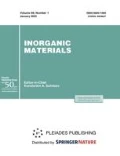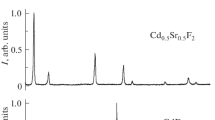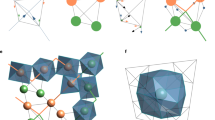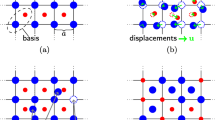Abstract—
The heat capacity Cp(T) of cadmium fluoride, strontium fluoride, and the Cd0.5Sr0.5F2 solid solution has been studied experimentally (2–300 K). We have detected deviations ΔCp(T) of the Cp(T) data from additivity. The low-temperature (2–50 K), positive deviations ΔCp(T) have been tentatively attributed to the effect of two-level systems associated with the glasslike character of the low-temperature thermal properties of the solution due to disorder in the Cd–Sr sublattice. The high-temperature (100–300 K), negative deviations ΔCp(T) are caused by the effect of anharmonicity of lattice vibrations, whose increasing role is also associated with the disordered arrangement of atoms in the crystal lattice upon formation of the solution. The Cp(T) data for the solution of the system studied have been analyzed in the Debye–Einstein model. We have determined model parameters: characteristic temperatures Θi and the fractions of different contributions, ai, to total thermal characteristics of the substances studied.
Similar content being viewed by others
INTRODUCTION
Upon the formation of substitutional solid solutions between substances A and B, atoms of substance A occupy lattice sites on which atoms of substance B have been located before. As a result, the solution loses individual properties of substance A, without acquiring properties of substance B. Properties of a solution are quantitatively characterized by physical parameters of its state. These quantities of a solution take some intermediate values between the corresponding characteristics of substances A and B. If some characteristic of a solution is denoted Ɛ and the corresponding quantities for substances A and B are denoted ƐA and ƐB, in the simplest model we have

where x is the concentration of substance A in the solution and 1 – x is the concentration of substance B. If Ɛ is taken to mean, for example, a lattice parameter, relation (1) represents Vegard’s law. In the case of heat capacity, it is the Neumann–Kopp rule, etc. Strictly speaking, however, the additivity relation (1) is only valid for a two-phase mechanical mixture of substances A and B. In real single-phase substitutional solutions, distinctions between individual characteristics of atoms A and B (their mass and volume, the way in which their electron shells are filled, etc.) lead to deviations from the additivity rule. Sometimes, such deviations are small, often smaller than measurement uncertainties. Condition (1) is then thought to be fulfilled for the solution. This is the case, for example, for lattice parameters, density, and some other characteristics of binary, pseudobinary, and more complex solutions (alloys) [1–4]. Some characteristics, such as, for example, thermal conductivity and electrical conductivity, exhibit considerable deviations from relation (1) [5–8].
The heat capacity of solid solutions in various systems exhibits slight, but quite systematic, deviations from (1) (Neumann–Kopp rule). In general terms, the deviations originate from the specifics of phonon spectra of solutions. However, this formulation does not help to gain insight into the physical processes behind these specifics.
With the quantitative diversity of deviations of physical characteristics of alloys from their additive values, it is desirable to identify some key cause responsible for the deviations. In our opinion, such a cause (at least when it comes to the thermal properties of solid solutions: thermal expansion, heat capacity, and thermal conductivity) is the lack of perfect order in the crystal structure of a solution, where atoms of one kind are replaced by atoms of another kind, with other individual characteristics. Such disorder can impart glasslike properties to the solution at low temperatures [8, 9] or increase the effect of anharmonicity of lattice vibrations on thermal properties at elevated temperatures [10].
The CdF2–SrF2 continuous solid solution series [11] includes the congruently melting compound Cd0.75Sr0.25F2. This offers the possibility of obtaining homogeneous single-crystal solution samples with this composition [12] and is, therefore, of considerable practical interest.
The objectives of this work were to experimentally demonstrate characteristic features of the temperature variation of the heat capacity of the Cd0.5Sr0.5F2 solid solution in the range 2–300 K and construct a model for describing the observed anomalies.
EXPERIMENTAL
CdF2 and SrF2 samples were synthesized by dissolving appropriate metal carbonates in an excess of hydrofluoric acid. The carbonates were prepared using the following chemicals: CdSO4 (reagent grade), SrCl2 (analytical grade, prepurified via recrystallization), K2CO3 (reagent grade), and HF (reagent grade). Solutions of these chemicals were first left to stand for five days, then decanted, and filtered through Schott no. 4.
Mixing equivalent amounts of hot solutions (except for potassium carbonate, which was added in a 5% excess), we obtained carbonates of appropriate cations. The carbonate precipitate was washed with double-distilled water until tests for chloride and sulfate anions for SrCO3 and CdCO3, respectively, were negative. After drying, the carbonates were converted into fluorides by dissolving them in 40% hydrofluoric acid (10% excess). The fluoride precipitate was vacuum-dried at 200°C for 2 h. The hydrogen fluoride captured by the precipitate was removed during the drying process. The synthesized polycrystalline fluoride samples had a pure white color.
To prepare a sample of the Cd0.5Sr0.5F2 solid solution, weighed stoichiometric amounts of cadmium and strontium fluorides were mixed in an agate mortar and ground under a hexane layer. The resultant mixture was ultrasonicated for 30 min. The precipitate was separated from the nonaqueous solvent by decantation. To further remove the solvent, the precipitate was held in a vessel under vacuum. Next, the powder sample was pressed at 60–80 kN in a 13-mm-diameter alloyed steel cuvette with no binder. The resultant pellets were placed in a graphite crucible and then in a quartz ampule. After pumping to 10–2 mm Hg, the pellets were heated in an induction furnace (15 min) to 0.75 of the melting point of the lower melting point component and held at this temperature for 30 min. The surface of the samples thus prepared was cleaned where it was in contact with the graphite crucible.
The Bragg peaks in the X-ray diffraction pattern of the synthesized solid solution were essentially as narrow and sharp as those of the constituent fluorides: CdF2 and SrF2. Chemical and spectral analyses of the synthesized solid solution confirmed that its composition corresponded to the intended stoichiometry.
The 300-K lattice parameters of the synthesized fluorides and fluoride solid solution are given in Table 1.
The heat capacity of the cadmium fluoride and strontium fluoride samples and the solid solution was measured in the range 2–300 K in a Termaks automated adiabatic calorimeter with periodic heating (Mendeleevo, Moscow oblast, Russia) [13–15]. Uncertainty in our measurements was within 3% in the range 2–15 K, decreased to 1% near 60 K, and remained at this level up to room temperature. The above uncertainty was confirmed by calibration measurements on an electrolytic copper sample, which was remelted and annealed under vacuum.
RESULTS AND DISCUSSION
The purpose of this study was to gain insight into the nature of the anomalies in the temperature dependence of heat capacity for the Cd0.5Sr0.5F2 solid solution by analyzing Cp(T) data for the constituent fluorides and solid solution in terms of the Debye–Einstein model with allowance for anharmonicity of lattice vibrations.
Figure 1 shows temperature dependences of heat capacity for cadmium fluoride, strontium fluoride, and the Cd0.5Sr0.5F2 solid solution at temperatures from 2 to 300 K.
Note that our data for CdF2 are in excellent agreement with previously reported results [16, 17].
We call attention to the specific features of the mutual position of the Cp(T) curves of the constituent fluorides and the solid solution. As seen in Fig. 1, there is an inversion (intersection) of the Cp(T) curves of CdF2 and SrF2 at Tinv ≈ 75 K. Clearly, an important role is here played by the different effects of the massive cations and lighter anions in the crystal structure of the fluorides on their heat capacity. At low temperatures, low-frequency vibrations in the phonon spectrum of the fluorides (vibrations of the Cd2+ and Sr2+ massive cations) are excited in larger measure. Since the mass of the Cd2+ ion markedly exceeds that of Sr2+, the Cd2+ sublattice has a lower vibrational frequency than does the Sr2+ sublattice. The characteristic temperature of the Cd2+ sublattice is, accordingly, lower than that of the Sr2+ sublattice and its heat capacity is higher, as observed in experiments. At elevated temperatures, the role of the high-frequency vibrations of the F– anion sublattice, the same in the solution system under study, gradually increases. Here, an additional factor influencing thermodynamic properties comes into play: interatomic distance. The lattice parameter of cadmium fluoride is \({{a}_{{{\text{Cd}}{{{\text{F}}}_{{\text{2}}}}}}}\) = 5.393(3) Å [18] and that of strontium fluoride is \({{a}_{{{\text{Sr}}{{{\text{F}}}_{{\text{2}}}}}}}\) = 5.800 Å [19]. Therefore, the ions in the F– sublattice of cadmium fluoride are located closer to each other. The energy of their interaction is higher and, hence, their vibrational frequency and characteristic temperature are also higher. Therefore, the contribution to the heat capacity of the fluoride turns out to be smaller (see Fig. 1).
The Cp(T) curve of the Cd0.5Sr0.5F2 solid solution exhibits rather unusual behavior. At low temperatures, the measured heat capacity of the solution exceeds not only the calculated additive heat capacity value Cadd(T) =  + \((1 - x){{C}_{{{\text{Sr}}{{{\text{F}}}_{{\text{2}}}}}}},\) but also the heat capacity of CdF2, the higher of the heat capacities of the constituent fluorides. As the temperature is raised, the picture changes to the opposite one: the heat capacity of the solution becomes lower than that of CdF2 (Fig. 1).
+ \((1 - x){{C}_{{{\text{Sr}}{{{\text{F}}}_{{\text{2}}}}}}},\) but also the heat capacity of CdF2, the higher of the heat capacities of the constituent fluorides. As the temperature is raised, the picture changes to the opposite one: the heat capacity of the solution becomes lower than that of CdF2 (Fig. 1).
To find out the origin of this unconventional ΔСV(T) behavior (see Fig. 2), temperature dependences of heat capacity, СV(T), for CdF2, SrF2, and Cd0.5Sr0.5F2 were analyzed in the Debye–Einstein approximation [20, 21]. The isochoric heat capacities СV(T) of cadmium and strontium fluorides were calculated using the relation
Here, Vm is the molar volume, β is volume thermal expansivity, æТ is isothermal compressibility, and T is the absolute temperature [22]. For the composition of the solid solution under study, the difference between its isobaric and isochoric heat capacities was calculated using the relation
where the A of the solution was determined as an additive quantity with respect to the A values of the components of the solution.
Figure 3 illustrates the fitting of the CV(T) data for cadmium fluoride in the Debye–Einstein model.
In the approximation chosen, the experimental CV(T) data for cadmium and strontium fluorides were fitted to the relation
Here, CD and CiE are the Debye and Einstein contributions to the heat capacity of the fluoride and ai are the coefficients determining the fraction of the ith contribution to total heat capacity. The fitting parameters are the coefficients ai and the characteristic temperatures ΘD, Θ1E, and Θ2E.
At first glance, unique determination of this large number of fitting parameters is a rather difficult, if solvable, problem. However, it can be simplified if we take into account the following: The sum of the coefficients ai (in calculating heat capacity per gram-atom) should be near unity. The plot of CV/T3 against T2 (see Fig. 3a) clearly demonstrates a low-temperature horizontal portion corresponding to Debye’s T3 law, which allows aD and ΘD to be readily determined. The low-temperature hillock is due to the low-frequency Einstein contribution. Its position on the T2 axis determines Θ1E and its height determines a1E. Finally, the adequacy of the above approach to the fitting of the temperature dependence of heat capacity is demonstrated by numerous examples of successful analysis of components of the heat capacity of substances of various classes and is confirmed by the fact that the fitting parameters thus obtained are consistent with Raman scattering and spectroscopic data [23, 24].
To analyze features in the temperature dependence of heat capacity for the Cd0.5Sr0.5F2 solid solution, we used the following approach: First, we calculated the heat capacity of the solution using the Neumann–Kopp (additivity) rule (NKR):
The Cadd(T) data for the solution were analyzed like the CV(T) data for the constituent fluorides (relation (4)). Using a fitting procedure, we determined aD, ΘD, a1E, Θ1E, a2E, and Θ2E for the additive temperature dependence of the heat capacity of the solution. Figure 4 shows the experimental CV(T) data for the composition Cd0.5Sr0.5F2 and the calculated additive temperature dependence Cadd(T).
As follows from Fig. 4a, the low-temperature hillock in the plot of Cmeas(T)/T3 against T2 is shifted to lower temperatures relative to the additive dependence and is markedly higher. It is seen in Fig. 4b that the high-temperature Cmeas(T) is markedly lower than the calculated Cadd(T) of the solution.
Let us try to find out the nature of these anomalies.
In our opinion, the low-temperature and high-temperature deviations of the heat capacity of the solid solutions are due to the disorder in the spatial arrangement of ions in the crystal lattice upon the formation of the solid solution.
During the formation of the solution, Cd2+ and Sr2+ ions occupy lattice sites at random. At low temperatures, spatial disorder leads to manifestation of a glasslike character of the thermal properties of the solution [8], which is characterized, in particular, by the formation of two-level systems (TLS’s) [25]. These are responsible for the increasing role of low-frequency modes in the formation of the thermal properties of the solution, which leads to an anomalous increase in its heat capacity at low temperatures. It is this increase in heat capacity over NKR values that is observed in Fig. 4a, as well as in Fig. 2, which shows the temperature variation of the difference ΔC = Cmeas – Cadd for the Cd0.5Sr0.5F2 solid solution.
The increase in the heat capacity of the solution was taken into account by adding a contribution of two-level systems (TLS’s), CTLS(T) (see Figs. 4a and 2).
A disordered arrangement of ions in the crystal structure of the solution at elevated temperatures (150–300 K) leads to an increasing effect of anharmonicity of lattice vibrations on the thermal properties of the solution [26].
In the harmonic approximation, the potential energy of interaction between ions, U(x), is proportional to the square of the displacement x of an ion from its equilibrium position. In the case of considerable displacements (at elevated temperatures), U(x) depends on higher powers of x [27]:
Here the terms containing x3 and x4 correspond to an anharmonic component of the potential energy.
In fitting the CV(T) data for the Cd0.5Sr0.5F2 solution at elevated temperatures, we used the Mukherjee–Bansal–Chatterjee approach [28], which implements the Debye–Einstein model with allowance for anharmonicity. Table 1 lists the model parameters ai and Θi obtained by the fitting process and the parameters f and g'', responsible for the anharmonicity contribution to thermal characteristics.
It follows from Table 1 that, for describing the experimentally determined temperature dependence CV(T) for the Cd0.5Sr0.5F2 solid solution, we used the same CD(T) and C1E(T) contributions as in the case of the additive dependence Cadd(T), adding the contribution of two-level systems, CTLS(T), and increasing the characteristic temperature Θ2E from 420 to 490 K. Moreover, we took into account the effect of anharmonicity.
The high-frequency Einstein contribution to heat capacity, C2E(T), characterizes vibrations of the F– sublattice. Even though cadmium and strontium difluorides have identical anion sublattices, substitution of one cation for another, differing markedly in mass and size, leads to distortion of the entire crystal lattice, including bond rearrangement in the anion sublattice. The resulting mechanical stress leads to an increase in bond energy in the F– sublattice. These changes increase the vibrational frequency of the F– sublattice and, hence, the characteristic temperature Θ2E, leading to a reduction in the corresponding Einstein contribution to the heat capacity of the solution. Thus, the opposite effects of disorder in the crystal lattice of the solid solution lead to anomalous deviations of its heat capacity from additive values at low and elevated temperatures.
CONCLUSIONS
The results of the present experimental study of the heat capacity of CdxSr1 –xF2 solid solution demonstrate the following:
The temperature variations of the heat capacity of the constituent fluorides CdF2 and SrF2 in a wide range of low temperatures, from 2 to 300 K, can be adequately described by a combination of the Debye contribution and two Einstein contributions. The characteristic temperatures of the Debye components in the heat capacity of cadmium and strontium difluorides differ little, as do their high-frequency Einstein temperatures, because they characterize vibrations of the anion sublattices, which are identical in the constituent fluorides.
In fitting the experimentally determined temperature dependence of heat capacity for the Cd0.5Sr0.5F2 solid solution, it was possible to use characteristics of the Debye (aD and ΘD) and low-frequency Einstein (aE1 and ΘE1) contributions calculated from heat capacity data for the constituent cadmium and strontium fluorides using the NKR.
To reproduce the low-temperature part of the CV(T) data for the solution, it was necessary to add the TLS contribution, associated with the effect of disorder in the spatial arrangement of the Cd2+ and Sr2+ ions in the crystal structure of the solution.
The high-frequency Einstein contribution CE2(T) to the heat capacity of the solution is characterized by a higher characteristic temperature in comparison with the corresponding additive dependence as a consequence of the effect of anharmonicity of lattice vibrations, whose significant role at elevated temperatures is also due to the disorder in the crystal structure of the solution.
REFERENCES
Crundwell, G.A., Cowans, B.A., Hopkins, J.A., Grutzner, J.B., and Kahr, B., Vegard’s rule revisited in BaxPb1 –x(NO3)2 by NMR and XRD, J. Solid State Chem., 1999, vol. 145, pp. 327–335.https://doi.org/10.1006/jssc.1999.8288
Mukherjee, S., Ranjan, V., Gupta, R., and Garg, A., Compositional dependence of structural parameters, polyhedral distortion and magnetic properties of gallium ferrite, Solid State Commun., 2012, vol. 152, pp. 1181–1185.https://doi.org/10.1016/j.ssc.2012.03.010
Magalhães, S., Franco, N., Watson, I., Martin, R., Donnell, O., Schenk, H., and Tang, F., Validity of Vegard’s rule for Al1 –x InxN (0.08 < x < 0.28) thin films grown on GaN templates, J. Phys. D: Appl. Phys., 2017, vol. 50, paper 205107.
Schenk, M. and Silber, C., Solid-solution hardening and Vegard’s rule of In1 –xGaxSb, J. Mater. Sci. – Mater. Electron., 1998, vol. 9, pp. 313–316.https://doi.org/10.1023/A:1008837008832
Terada, Y., Ohkubo, K., and Mohri, T., Thermal conductivity in nickel solid solutions, J. Appl. Phys., 1997, vol. 81, pp. 2263–2268.https://doi.org/10.1063/1.364254
Rogacheva, E.I., Doroshenko, A.N., Nashchekina, O.N., and Men’shov, Yu.V., Thermal conductivity in Bi1 –xSbx solid solutions, J. Electron. Mater., 2013, vol. 42, no. 7, pp. 2098–2102.https://doi.org/10.1007/s11664-013-2534-y
Abrahams, M.S., Braunstein, R., and Rosi, D., Thermal, electrical and optical properties of (In,Ga)As alloys, J. Phys. Chem. Solids, 1959, vol. 10, pp. 204–210.https://doi.org/10.1016/0022-3697(59)90076-9
Zamyatin, D.A., Shchapova, Yu.V., Votyakov, S.L., Eremin, N.N., and Urusov, V.S., Structure and thermodynamic properties of zircon–coffinite solid solutions according to the semiempirical atomistic simulation data, Glass Phys. Chem., 2013, vol. 39, no. 2, pp. 182–192.https://doi.org/10.1134/S108765961302017X
Parshin, D.A., Interactions of soft atomic potentials and universality of low-temperature properties of glasses, Phys. Rev. B: Condens. Matter Mater. Phys., 1994, vol. 49, pp. 9400–9417.https://doi.org/10.1103/PhysRevB.49.9400
Novikov, V.V., Zhemoedov, N.A., Matovnikov, A.V., Mitroshenkov, N.V., Kuznetsov, S.V., and Bud’ko, S.L., Negative thermal expansion and anomalies of heat capacity of LuB50 at low temperatures, Dalton Trans., 2015, vol. 44, no. 36, pp. 15865–15871.https://doi.org/10.1039/C5DT01406A
De Kozak, A., Samouel, M., and Chretien, A., Misibility crystalline des fluorures de calcium, de strontium et de plomb dans de fluorine de cadmium, Rev. Chim. Miner., 1971, vol. 8, pp. 805–811.
Buchinskaya, I.I. and Fedorov, P.P., A new optical medium—Cd0.75Sr0.25F2 single crystals, Crystallogr. Rep., 2004, vol. 49, no. 2, pp. 279–281.https://doi.org/10.1134/1.1690431
Novikov, V.V., Mitroshenkov, N.V., Matovnikov, A.V., Avdashchenko, D.V., Trubnickov, S.V., and Morozov, A.V., Peculiarities of the lattice thermal properties of rare-earth tetraborides, J. Therm. Anal. Calorim., 2015, vol. 120, no. 3, pp. 1597–1602.https://doi.org/10.1007/s10973-015-4475-6
Novikov, V.V., Chukina, T.A., and Verevkin, A.A., Anomalies in thermal expansion of rare-earth diborides in the temperature range of magnetic phase transformations, Phys. Solid State, 2010, vol. 52, no. 2, pp. 364–369.https://doi.org/10.1134/S106378341002023X
Novikov, V.V., Avdashchenko, D.V., Matovnikov, A.V., Moiseev, N.V., Budko, S.L., and Tanaka, T., Thermal and magnetic properties of DyB62 at low temperatures, Phys. B: Condens. Matter, 2011, vol. 406, no. 13, pp. 2642–2645.https://doi.org/10.1016/j.physb.2011.04.006
Novikov, V.V., Mitroshenkov, N.V., Matovnikov, A.V., and Kuznetsov, S.V., Specific features of lattice dynamics of (CaF2)x(SrF2)(1 –x) solid solutions, Mater. Chem. Phys., 2020, vol. 240, paper 122247.https://doi.org/10.1016/j.matchemphys.2019.122247
Gavrichev, K.S., Fedorov, P.P., Tyurin, A.V., Ryumin, M.A., Khoroshilov, A.V., and Buchinskaya, I.I., Heat capacity and thermodynamic functions of cadmium fluoride, Russ. J. Inorg. Chem., 2009, vol. 54, no. 9, pp. 1445–1450.https://doi.org/10.1134/S0036023609090174
Ryzhova, E.A., Molchanov, V.N., Artyukhov, A.A., Simonov, V.I., and Sobolev, B.P., Growth and defect crystal structure of CdF2 and nonstoichiometric Cd1 –xRxF2 +x phases (R = rare earth elements and In). 2. Methods of structure refinement of Cd0.90R0.10F2.10 phases using the example of Cd0.90Tb0.10F2.10. structure of nanodimensional clusters in Cd0.90Tb0.10F2.10 crystal, Crystallogr. Rep., 2004, vol. 49, no. 4, pp. 668–675.https://doi.org/10.1134/1.1780622
Soni, H.R., Gupta, S.K., Talati, M., and Jha, P.K., Ground state and lattice dynamical study of ionic conductors CaF2, SrF2 and BaF2 using density functional theory, J. Phys. Chem. Solids, 2011, vol. 72, pp. 934–939.https://doi.org/10.1016/j.jpcs.2011.04.018
Novikov, V.V., Matovnikov, A.V., Avdashchenko, D.V., Mitroshenkov, N.V., Dikarev, E., Takamizawa, S., Kirsanova, M.A., and Shevelkov, A.V., Low-temperature structure and lattice dynamics of the thermoelectric clathrate Sn24P19.3I8, J. Alloys Compd., 2012, vol. 520, pp. 174–179.https://doi.org/10.1016/j.jallcom.2011.12.171
Novikov, V., Pilipenko, K., Matovnikov, A., Mitroshenkov, N., Plokhikh, I., Tyablikov, A., and Shevelkov, A., Structure-related thermal properties of type-VII clathrates SrNi2P4 and BaNi2P4 at low temperature, Phys. Status Solidi B, 2018, vol. 255, no. 8, paper 1800067.https://doi.org/10.1002/pssb.201800067
Tari, A., The Specific Heat of Matter at Low Temperatures, London: Imperial College Press, 2003.
Novikov, V.V., Mitroshenkov, N.V., Kuznetsov, S.V., Popov, P.A., Buchinskaya, I.I., Karimov, D.N., and Koshelev, A.V., Anharmonicity of lattice vibrations and the thermal properties of Cd1 –xSrxF2 solid solutions, Phys. Solid State, 2020, vol. 62, no. 4, pp. 714–721.
Shein, I.R., Novikov, V.V., Kuznetsov, S.V., Ponkratov, K.V., Matovnikov, A.V., Mitroshenkov, N.V., Kornev, B.I., Morozov, A.V., and Prishchep, V.L., Thermodynamic properties and lattice dynamics investigation of LuB2C: experiment and ab-initio calculations, Phys. Chem. Chem. Phys., 2019, vol. 21, pp. 24684–24694.https://doi.org/10.1039/c9cp02880c
Wrubel, J.P., Hubbard, B.E., Agladze, N.I., Sievers, A.J., Fedorov, P.P., and Campbell, J.A., Glasslike two-level systems in minimally disordered mixed crystals, Phys. Rev. Lett., 2006, vol. 96, paper 235503.https://doi.org/10.1103/PhysRevLett.96.235503
Abeles, B., Lattice thermal conductivity of disordered semiconductor alloys at high temperatures, Phys. Rev., 1963, vol. 131, no. 51, pp. 1906–1011.https://doi.org/10.1103/PhysRev.131.1906
Kittel, C., Introduction to Solid State Physics, New York: Wiley, 1953.
Mukherjee, G.D., Bansal, C., and Chatterjee, A., Thermal expansion study of ordered and disordered Fe3Al: an effective approach for the determination of vibrational entropy, Phys. Rev. Lett., 1996, vol. 76, pp. 1876–1879.https://doi.org/10.1103/PhysRevLett.76.1876
Funding
This work was supported by the Russian Foundation for Basic Research and Bryansk oblast administration, grant. no. 18-42-320002.
Author information
Authors and Affiliations
Corresponding author
Rights and permissions
About this article
Cite this article
Novikov, V.V., Matovnikov, A.V., Mitroshenkov, N.V. et al. Structural Disorder and Heat Capacity of a Solid Solution between Cadmium and Strontium Fluorides. Inorg Mater 56, 626–632 (2020). https://doi.org/10.1134/S0020168520060096
Received:
Revised:
Accepted:
Published:
Issue Date:
DOI: https://doi.org/10.1134/S0020168520060096








